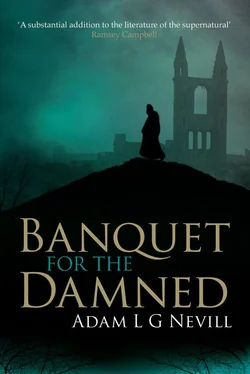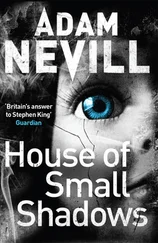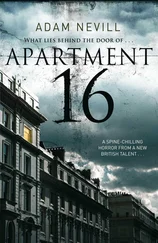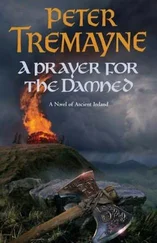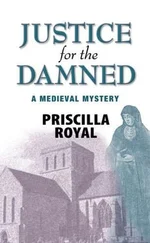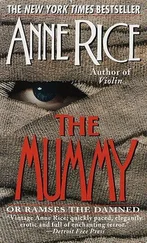'Yeah, sorry, that's right. But there's so many versions,' his friend says, and then whips a stone out to sea, which skims in three hops and sinks sideways. 'They're saying it was a cult started by Coldwell. A suicide cult.'
'I heard that too. It was in the Telegraph ,' the third man says, looking at the silhouette of the town, up the beach by the break waters and cliffs, that now seems more interesting to him than it ever did before. 'But that doesn't explain what people reckon they saw in the dorms. Did you read what those second-year girls said in The Independent ?' Before his friends can answer, he continues. 'After the fires started, they all saw something run down the Scores. And it wasn't a man, they say.'
'But that's crap,' the first speaker says. 'There'll be so many stories about the ghost. Loads of people claim they saw it. I even heard this morning that they called a priest out to the boarding school.'
'Yeah,' the second man says. He nods his head. 'A porter sounded the alarm. After some nun was found with her neck broken, I heard. But they're keeping it quiet because of all the kids that were in there. They saw it happen. It was going for the kids, I heard. I heard that this black thing, or whatever, was trying to get into their rooms.'
And then they all fall silent and, to distract themselves, as if uncomfortable with the thought, they look about on the sand for more stones to throw at the sea.
Back up in the dunes, the long-haired man is coughing again, and his face looks even paler from a distance because of the red scarf he wears. With the bandaged hand, he dabs at his lips and then puts both of his hands under his arms. He left the hospital at first light. He checked himself out, against the wishes of the staff, but left his friend behind. He was too ill to leave. He was still asleep with a plastic mask on his face.
From behind him, he hears feet scuffing through the sand. Alert to steps and sounds in a way he never was before, he turns his head despite the discomfort it causes him. He frowns. He blinks with disbelief. Recognition dawns across his face and he almost smiles. He swallows, and his jaw trembles from the emotion he appears to suffer.
'There you are,' a breathless girl says. Her slender body is wrapped up in a green fleece jacket and blue jeans. 'I've been looking everywhere for you. Oh thank God, you're all right, Dante.' She talks quickly as she skids down the sand dunes. 'I got the train up yesterday, when I heard about the fires, and I went to the address you gave me. At the flat. When I saw it all burned out, I panicked. I saw them cleaning it up, and I saw a bit of guitar. I broke down. And this policeman came over and said there were squatters in the flat, but nobody was hurt there. He said they were still looking for them. Then I came here just by chance to get my head together and I saw the Land Rover.'
In a daze, the young man watches her. She sits down beside him.
When she sees the look on his face, the bandaged hand, and the way his body is cramped up, she goes quiet. His clothes are filthy and he smells of smoke. 'The fire?' she asks.
He nods, but doesn't speak.
'Where's Tom?' she asks. Her voice is quiet, almost a whisper.
He looks at the sand and shakes his head. Then he covers his eyes by putting the unbandaged hand across his eyebrows. The girl puts her arm around his shoulders and rests her head against his temple. He puts his arm around her waist and begins to whisper in her ear. He whispers something that no one else on the beach or in the town will ever hear.
The End.
I would like to acknowledge the advice and support I received at the University of St Andrews on the Creative Writing Masters programme in 1997 and 1998. Professor Douglas Dunn, Brian McCabe, Jenny Itzenson and Brian St John made it a rewarding, stimulating and memorable year for me. Dave Addison and Adam Berger from Anthropology were also instrumental in helping me to create the character of Doctor Hart Miller.
In one respect this novel is as much about the actual town of St Andrews as anything else, a place with a timeless and curious magic all of its own. Throughout, I've tried to do justice to its graces and remain faithful to its topography, though creative licence has been used to alter the locations of some of the schools. And I can assure the reader that neither the cottage of Professor Eliot Coldwell nor the bewitched village of Knoxville exists (at least not at the locations given in the story).
Witchcraft and Sorcery by John A Rush, Appearances of the Dead by Ronald C Finucane, Witchcraft and Black Magic by the Reverend Montague Summers, The Terror that Comes in the Night by David Hufford, Witchcraft and Magic in Sixteenth and Seventeenth-century Europe by Geoffrey Scarre, Witchcraft in Europe 1100–1700: A Documentary History by Alan C. Kors, The European Witch-craze of the Sixteenth and Seventeenth-centuries by H.R. Trevor-Roper, Transition and Revolution by Robert M. Kingdon were essential in my research, but I admit taking great liberties with both European and Scottish history and folklore to suit my own malign purposes. The verse quoted in chapter four is from Aleister Crowley's King Ghost , the lyrics sung by Elaine in Chapter Forty-One are from 'Give Him A Great Big Kiss' by the Shangri-Las, and the quotation in Chapter Twenty-Five is from An Elizabethan Devil-Worshipper's Prayer Book .
Without the encouragement of the Nevill clan — mother, father, my brother Simon and sister Melissa — I might easily have spent three years doing something else, far less satisfying, than cooking up this Banquet for the Damned . And without the interest, the wit and the wisdom of James Marriott, John Coulthart, Ramsey Campbell, Peter Crowther of PS Publishing, and Nick Gevers, this night terror may never have been shared.
Penultimately, I'd like to acknowledge the Outsider books and ideas of Colin Wilson not only for the comfort and confirmation they still give me today, but for being the inspiration behind Professor Eliot Coldwell. And, finally, it would be most unwise of me — lest I'm visited by something unpleasant in the night — not to own up to the considerable debt I owe those great masters of terror, Walter de la Mare, M R James and Algernon Blackwood.
ABOUT THE AUTHOR
Adam L G Nevill was born in Birmingham, England, in 1969 and grew up in England and New Zealand. A graduate of the University of St Andrews Creative Writing Masters programme, he is the author of nine novels under a pseudonym for Virgin Books. His most recent short story appearance was featured in The Year's Best Fantasy and Horror 2006 , edited by Ellen Datlow, and The Mammoth Book of Best New Horror 17 , edited by Stephen Jones. Besides eight years spent as a librarian and researcher for several British television companies, he has endured a variety of occupations, including temporary office worker, night-club doorman, night watchman and porter. He currently lives in London and works in publishing.
